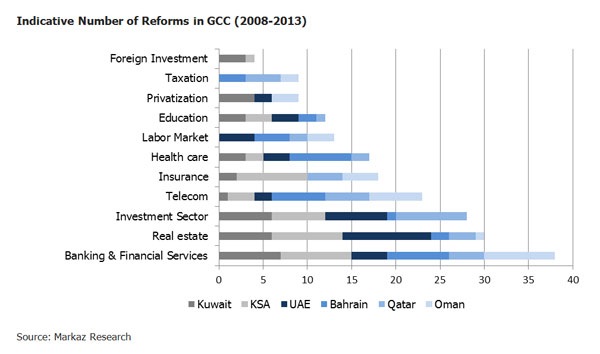Regulations and regulatory reforms are in vogue these days. The GCC has been witnessing a swathe of regulatory reforms in various sectors. How important is it to calibrate and balance reforms and regulations? This question has become hugely important in this setting.
Broadly speaking, regulations have the following characteristics:
1. Counter-cyclical nature: We see that policy makers wake up only when there is a disaster in the making! The global financial crisis of 2008 is a great example, post which, a wave of regulations evolved that was mainly aimed at the financial sector. We hardly see regulators active when the going is good. This is actually counter intuitive. Strong regulations should be introduced when the going is good, so that the stakeholders have the energy and the time to pursue them effectively. Locking the stable after the horses have bolted away does not make good sense!
2. Market Maturity: Regulations can be illustrated as distillations of wisdom gained from ongoing market experiments. Markets evolve over a period of time through multiple experiences and regulations are nothing but an accumulation of such experiences. The troughs and peaks as the markets waltz through time enable regulators to absorb lessons and implement relevant checks and balances as part of the continuous movement towards greater perfection. In that sense, regulations are milestones that indicate the levels of market maturity.
3. Investor Confidence: Properly introduced regulations and reforms can go much towards enhancing investor confidence. Lack of investor confidence primarily stems from a poor regulatory architecture. A case in point is the emerging and frontier markets, which in spite of its attractiveness, nevertheless suffers from poor investor confidence (especially foreign investors).
4. Ease of Doing Business: Regulations can go a long way in easing the way business is conducted. If enacted poorly, regulations can also contribute to the opposite. It is generally considered a best practice to measure the effectiveness and success of a particular regulation based on how well it facilitates ease of doing business. Ease of doing business is generally talked about in the context of foreign investors. I feel it does apply in equal measure to local businessmen.
5. Global Perception and Brand Building: Regulations can also contribute to enhanced and improved global perception about a particular market. Preservation of investor rights, intellectual property, speed of legal trials, can be cited as some examples that lead to the strengthening of a particular location or city as a brand (e.g.,Singapore). Major decisions, including setting up of manufacturing units, are critically based on the strength of global perceptions.
In the context of the aforementioned characteristics or essential features of regulations, it is worth mapping the framework to the GCC environment. The below chart illustrates the number of reforms, sector wise in the GCC, since 2008. It is interesting to note that foreign investment is an area where there have been only subdued regulatory movements; while Banking and Financial Services has witnessed intense regulatory pronouncements. There can be reasons for this. Attracting inward foreign capital may not be an immediate priority for liquidity rich GCC states. However, FDI is just not about attracting capital, only. Foreign investment can also enhance the talent pool in the region, bring new technologies, and above all, improve investor confidence and upgrade global perception. On the contrary, Banking and Financial Services is a dominant and highly mature sector contributing to over 50% of the market capitalization in the respective stock markets of the GCC countries. In the absence of an active debt market and due to a paucity of long-term funding instruments, banks end up being the primary mover of the financial wheel. This explains the “over regulated” nature of this sector.

So, what then makes regulations effective?
1. Balance: Under regulation may inhibit the growth of a sector; while excessive regulations may increase the cost of doing business. Hence, the need to balance regulations carefully.
2. Oversight: Declaring a regulation is only the opening gambit, while the real challenge lies in the implementation on the ground. A case in point are the Capital Market Authorities across many GCC countries. While CMAs’ require a spate of documentation to be submitted by the companies, they may not have the commensurate infrastructure or technology to monitor all the submissions and take action where necessary.
3. KPI’s: Regulations become effective only when regulators don’t limit their role to just policing and fining. The agenda of regulators should be more broad based and should include the development and growth of the sectors that they are regulating. If after a decade of regulations, a sector has failed to demonstrate growth and development, then the regulators should also share the blame!
4. Cost: Mindless regulations should be avoided as compliance cost is an important component with respect to economic efficiency. This is particularly true of “imported regulations”, which under the name of best practices, are whisked in with little consideration given to their applicability vis-à-vis local realities.
In summary, it can be said that there can be no doubt about the integral and important role that effective regulations have. The role that they play in the organized development of a market cannot be understated or deemphasized. However, calibrating regulations and achieving a fit balance is the need of the hour.
Stay Tuned To Marmore MENA Insights!
Never miss a patch or an update with Marmore's Newsletter. Subscribe now!
Related Article
The Dynamic Rise of Fintech in the GCC
The convergence of technology and finance is reshaping the GCC Financial Ecosystem. The blog explores key players, regulatory framework and market dynamics of Fintech in the GCC region.
Read MoreHow secure are GCC banks compared to their global counterparts?
The blog examines the impact of cyber attacks on financial institutions and the resiliency of GCC banks compared to their global counterparts
Read More2024 Kuwait Banking: Interest Rates and NIM Trend Analysis
The blog discusses how net interest margin of Kuwaits banks has moved across interest rate cycles, in light of awaited policy rate cuts.
Read MoreTags
No Tags!





